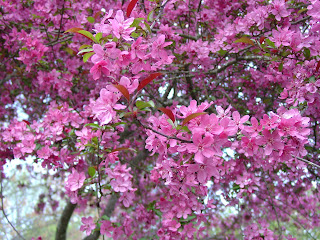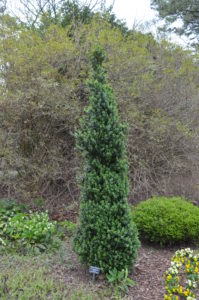Pruning An Old Nandina
Why My Tree Or Shrub Doesn’t Bloom
.jpg) Frustrated by a fruit tree or ornamental tree that does not bloom? There are 5 primary causes:
Frustrated by a fruit tree or ornamental tree that does not bloom? There are 5 primary causes:
- Lack of sunlight – insufficient light reduces flower bud development
- Fertility – too much nitrogen fed to plants can over-stimulate vegetative growth, either delaying or preventing flower bud development
- Winter injury or chilling tender flower buds in one or more spring frost
- Pruning at the wrong time of year, essentially removing all flowering wood
- Alternative (biennial) flowering when a plant bears too much fruit and will not initiate new flower bud for the next year
Big Begonias
Angelonia in the Summer Garden
Tired of marigolds and petunias? Angelonias (A. angustifolia) are superior summer garden annuals. Angelonias require very little care. They possess superior heat and drought tolerance.
Root Injury to Container Plants
The 4 most common reasons why gardeners lose outdoor container plants during the winters are:
1. Sub-freezing temps
2. Soil freezing for long periods
3. Waterlogged roots
4. Dessication from dry winter winds
Roots are not as cold hardy as above-ground shoots, trunks, branches, etc. Evergreen plants become more challenged when the soil media is frozen. Their leaves demand more water and nutrients that the roots are not able to supply from the frozen ground.
Root injury for most woody tree species begins at 22°F. This is soil that has little water in it. Keep in mind that water freezes at 32°F. So, one tip is to keep container plants watered, but not waterlogged. Most plants are injured when soil temps hit 16°F over a 24-hour period.
Pots must provide adequate drainage. Planting in a soil-less media containing high percentages of an organic component such as peat moss and/or compost, plus a gritty substance as coarse sand, tiny pea gravel or perlite for aeration and drainage. The pot should include bottom holes to weep out excess moisture.
Evergreens naturally shed most rain and snow like an umbrella and supplemental watering is critical for these plant compared to deciduous plants. Irrigate containers at least twice monthly, assuming that natural rain and snowfall will supply the rest.
Coral Bark Maple Blazes in the Winter Landscape
Princess Lilies — Hardy in Zone 6
Not all alstroemerias are alike. I have been enjoying my Princess lilies (alstroemeria hybrids from Holland) over the past 6 years. They have been surprisingly winter hardy in zone 6-b where I garden. Further south in zones 7 and 8, Princess lilies prefer part sun to partial shade.
I grow’em on the east side of the garden in full sun. The harsh afternoon sun of summer is filtered through the tall shrubs and trees nearby. Mulching the soil provides extra freeze protection to roots in the winter and guarantees their return next spring.
Princess lilies need little care after planting. I feed’em a handful of granular 10-10-10 around each plant in late winter. Give them a weekly irrigation for 1/2 hour or more during summer dry spells. Plants grow short and compact and are also suitable for containers on the deck or patio.
Currently, there are 17 varieties, richly colored in whites, yellows, pinks and reds. This spring I will be adding 1 or 2 new Princess lilies to the perennial flower border .
‘Sky Pencil Holly vs ‘Dee Runk’ Boxwood
Boxwoods and hollies are mainline evergreen shrubs, utilized for low hedging, privacy barriers. Single shrubs are planted solely for their architectural accent. Both hollies and boxwoods grow best in moist, well-drained soils and in full sun to partial shade. Both prefer soils with a pH of slightly acidic to slightly alkaline. Boxwoods tend to be more shade tolerant than Japanese hollies. In winter plant foliage may scorch or bronze if grown in open sun.
Planting Leyland Cypress May Be Big Mistake
 If you live in USDA Plant Zone 6-b – 7, planting leyland cypress (x Cupressocyparis leylandii) could eventually turn into a maintenance diseaster in your landscape. Leyland cypress is a green behemoth, too fast and aggressive for most folks to handle. Ask yourself, “do you really need a 60-70 foot evergreen privacy screen around your property?” If neighbors can’t view in, you can’t see out.
If you live in USDA Plant Zone 6-b – 7, planting leyland cypress (x Cupressocyparis leylandii) could eventually turn into a maintenance diseaster in your landscape. Leyland cypress is a green behemoth, too fast and aggressive for most folks to handle. Ask yourself, “do you really need a 60-70 foot evergreen privacy screen around your property?” If neighbors can’t view in, you can’t see out.
Beware of Storm Damaged Trees
This past weekend Northeast Tennessee as well as most of the coastal eastern U.S. was hit by heavy snow, 7 inches and more of heavy, wet clinging snow. Many of my neighbors lost electric power, telephone and cable.
A driveby survey of tree damage around the neighborhood found that the following tree species suffered the most breakage (in order of severity):
- Chinese (Siberian) elm
- Silver maple
- White pine
- Weeping cherry (pictured)
- Topped trees
- Bradford (callery) pear
- Red maple
- Dead or dying trees
- Sycamore (London planetree)
- Southern magnolia
- Sweetbay magnolia
- Yoshino cherry
- Dogwood
The type of injury ranged from large falling limbs two inches or more in diameter (Chinese elm, white pine, and silver and red maples) to many small branches less than one inch diameter (weeping cherry. magnolias and dogwoods).
Lessons learned:
- Select a tree species that is reliably storm resistant. Expect some limb breakage on any tree species, but fast growing trees like Chinese elms and silver and red maples, and those that are not properly maintained, suffer the most damage. When homeowners properly prune landscape trees every 5 years, storm damage is considerably less.
- Old mature trees, which have outlived their expected life span, should be removed and replanted with younger specimens. For example, Chinese elm, silver maple and white pine reach full maturity within 40 years. Bradford pear has a short replacement time of 15 years. Pruning maintenance on all landscape trees should be every 5-7 years.
- Topped trees suffered considerable limb losses as the weakened re-growth is exceptionally susceptible to breakage. The topping of trees is never a recommended practice. In my opinion, if a large tree threatens your home, personal property or utility lines, either seek care advice from a professional arborist or have the tree removed by a licensed and bonded arborist.
- Previously dead or dying trees pose a bigger hazard during in a storm.



